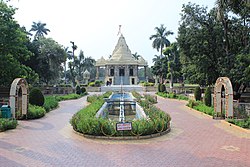Kayavarohan
This article needs additional citations for verification. (January 2017) |
This article may need to be rewritten to comply with Wikipedia's quality standards. (January 2017) |
Kayavarohan | |
|---|---|
village | |
UTC+5:30 (IST) | |
| Vehicle registration | GJ-06 |
| Website | gujaratindia |
Kayavarohan or Karvan is a village in the
History
Kayavarohan (Karvan) is an ancient town believed to have existed through each of the
A number of copper coins and a stone quern have been found from here. A beautiful head of Tapas, the image of Kartikeya and an idol of Uma Maheshwara are some of the archaeological specimen discovered from here that are preserved locally in a museum.
Religious Significance

Kayavarohan is one of the sixty-eight ‘teerthas' (Pilgrimage) of
It is of great significance to the
Kayavarohan harbours the Brahmeshwar Jyotirshivlang temple, claimed to have been founded by Maharshi
The Kayavarohan lingam represents the "formless" but a unique, exceptional iconic form of Shiva bearing the image of a meditating yogi, who holds parchments in one hand and citron (Matulinga) in the other.
It is believed the main place of pilgrimage was Ichhapuri in
period.In the
The myth has it that during the barbarian invasion of Mahmood of Ghazni, the luminous jyotirlinga with
Presently, there is an underground meditation cave at the Kayavarohana temple used for seclusion and meditation.
There is a Swaminarayan Hindu temple built by Haricharandas Swami in
Maha
Archaeological Significance

The village and its surrounding areas are of great archaeological significance. Ancient sculptures and relics belonging to the second century have been excavated from this place.
The Shiva temples at Karvan are said to have been destroyed during invasions of 11th-17th century. However, the
The temple of Lakulish and temples of Karvan were rebuilt and restored during the late twentieth century by the Hindu spiritual leader Kripalvanand.[2]

Numerous Hindu icons, number of copper coins and a stone quern have been found from Kayavarohan. A grand head of Tapasvi, the image of Kartikeya and an idol of Uma Maheshwara are some of the rare and unmatched archaeological specimen discovered from Kayavarohan. Kayavarohan is a place of great archaeological importance and the A.S.I. Archaeological Survey of India has listed Karvan as a heritage site and has set up a special museum for the remains found around this site. Karvan is one of the major sites of Indian Heritage.
See also
References
- ^ "Home". ktss.in.
- ISBN 978-0-8160-7564-5.
